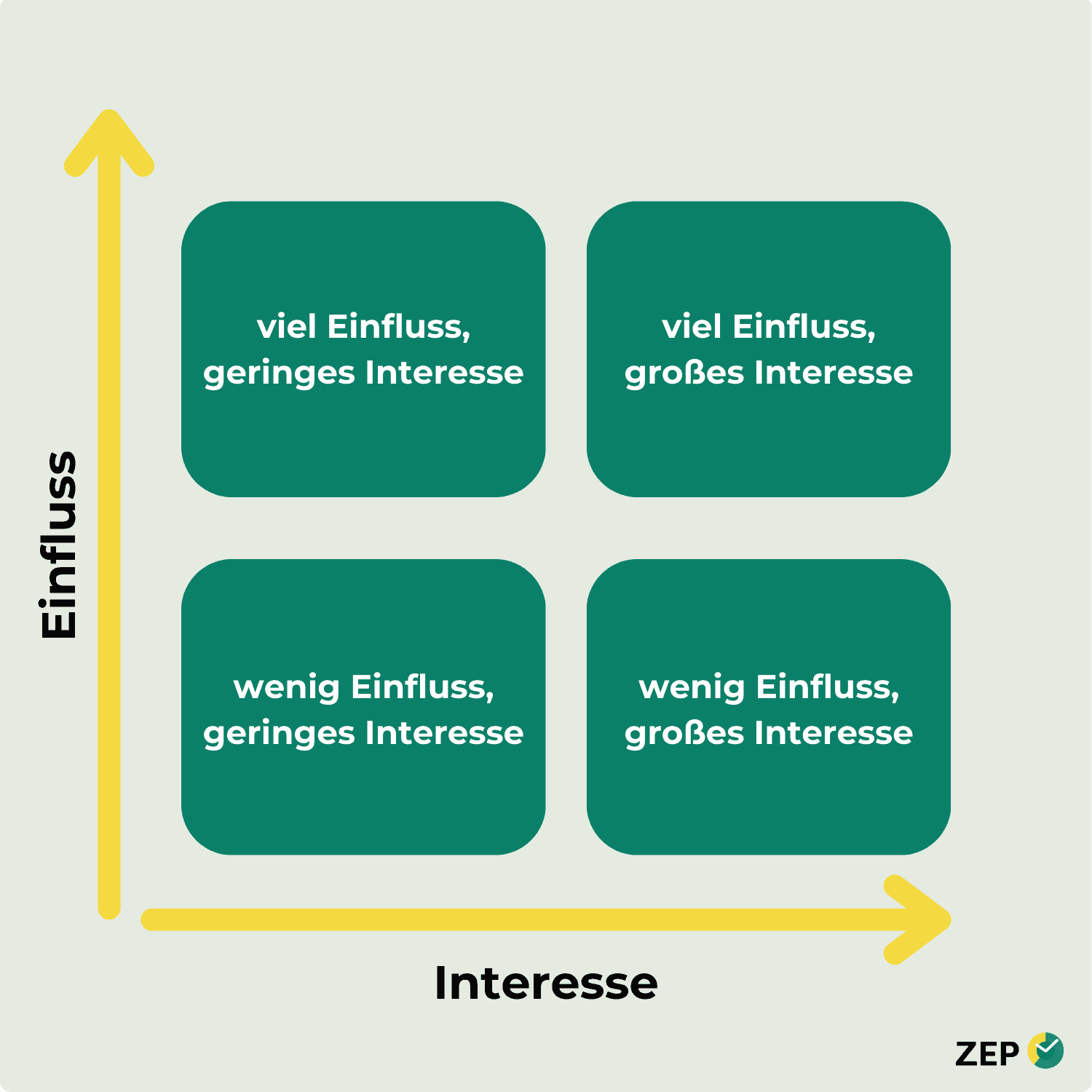
In project management, one fundamental rule is always present: the successful progress of projects requires not only technical knowledge, but also a deep understanding of the people involved. Stakeholder analysis is an effective tool that not only accelerates project success, but also efficiently defuses potential conflicts.
The aim of this analysis is to precisely identify different stakeholder groups, understand their individual interests and develop innovative ways to optimise the integration of these interests into the project. The stakeholder analysis thus proves to be the key to the targeted design of a successful project process and to mastering potential challenges with confidence.
In this blog article, we take a detailed look at how stakeholder analysis works and the crucial role it plays for you as a project manager. Discover how this tool can help take your projects to a new level of success.
Table of contents - What you can expect:
Carrying out a stakeholder analysis
Risk assessment for a stakeholder analysis
Technical support with ZEP
Duration of a stakeholder analysis
The DIN 69901-5:2009 defines the stakeholder analysis as follows:
In simpler terms, a stakeholder analysis refers to the systematic categorisation of stakeholders and the attempt to predict their influence on specific decisions. The starting point for this process is, as the name suggests, the stakeholders.
Carrying out a stakeholder analysis enables you to identify all the players involved in your projects and record their requirements, needs and wishes. Through the transparent presentation and potential influence of existing opinions, you can gain supporters or recognise resistance more easily.
Stakeholder analyses are crucial for the long-term stability of your company. Neglecting these stakeholders can lead to project failures, which in turn jeopardises your business success. Effective utilisation of the results of a stakeholder analysis, on the other hand, can sustainably improve the image of your projects. Simply engaging with stakeholders as part of an analysis helps them to feel recognised and taken seriously.
In many projects, the stakeholder analysis is often limited to the beginning of the project - during the phase of Project planning. A more efficient approach is to continuously review the stakeholder analysis over the course of the entire project and adapt it if necessary. Important: Always make sure it is up to date! The opinions and attitudes of your stakeholders may well change over the course of the project. In addition, a continuous review makes it easier for you to adjust any incorrect assessments made at the start of the project.
Stakeholder analyses are suitable for various types of projects. In particular, they prove to be extremely useful for extensive construction projects or large infrastructure projects, as these projects have far-reaching and lasting effects on nature, the environment and local residents.
If you fail to carry out a stakeholder analysis and plan communication measures based on this, this can have a negative impact on the progress of your project. In the worst case scenario, the entire project could fail.
In large companies, it has become an internal obligation to include a stakeholder analysis in the sustainability report. Such analyses classify the individual stakeholders and highlight the effects in relation to these groups.
For a comprehensive analysis, we recommend that you follow the following four steps, which are now considered the standard sequence for a stakeholder analysis. Of course, these are only recommendations and you can also introduce alternative methods in your organisation to carry out this analysis. This could be the case, for example, if you know exactly how internal stakeholders feel about your project or if any external stakeholders can be neglected.
To be able to identify all relevant stakeholders, you need to know the project process and its most important milestones before starting the analysis. In this way, you can determine the points of contact with your stakeholders, although these may differ depending on the project phase.
Record all persons, regardless of whether they are natural or legal persons, who (could) exert influence on your projects. Document the relevant contact details and ideally also the best time to contact these people. You can also record geographical locations that could also become relevant.
You have various options for generating information for the stakeholder analysis:
We recommend starting the interviews or workshops as early as possible. You should not perceive the discussions with the stakeholders as an "interrogation", as your aim is to get your stakeholders on board, value them and inform them about your project. In these discussions, both parties can express wishes, hopes, but also criticism and unease.
The openness and trustworthiness that you bring to these discussions will have a significant influence on the overall result. The way in which information is gathered is at the discretion of the project management. You can interview stakeholders individually, hold large-scale events or organise focus groups. However, make sure that you do not involve groups with different interests at the same time. This will help you avoid potential conflicts and emotional discussions. It is better to bring together groups with similar interests.
In any case, you should document all discussions you have as part of the stakeholder analysis - whether interviews, workshops or major events - in order to record all relevant information.
Once you have identified your stakeholders and gathered all the relevant information for your project, the third step is the evaluation. The easiest and most common way to do this is via a stakeholder matrix - also known as a Project environment analysis.
You can use this data to identify potential points of conflict and assess the possible effects. Which specific influencing factors are included in the matrix depends on the individual requirements of your project.
If you intend to publish your stakeholder analysis, it is very important to formulate the wording of the analysis in such a way that individual persons or groups are not publicly exposed. It is advisable to use language that is as neutral as possible.
For an appealing and comprehensible presentation of your results, it is a good idea to visualise the stakeholders and their interests and influence using a stakeholder map.

To visualise the influence of each stakeholder on your project, you can divide them into different categories:
Participative stakeholders should be actively involved in your project, as they have a high level of influence and contribute significantly to Project success can contribute. They play a decisive role in discussion and decision-making rounds and should be able to actively participate.
Discursive stakeholders should also be taken very seriously, even if their involvement is generally less intensive due to their limited influence. Nevertheless, they can also contribute decisive views or arguments to the course of the project.
Your dealings with restrictive stakeholders is particularly important. This group will not actively participate in the project, as it would probably not promote progress. Nevertheless, it is important that you address this group through personal conversations or other marketing measures of the project and try to convince them. Of course, it is also crucial to keep this group informed about project progress so that everyone is on the same page at all times. As you know, opinions and views on a project can change during the course of the project. Perhaps you can convince some stakeholders to support your project to a certain extent by communicating transparently and explaining the progress of the project.
A detailed stakeholder analysis is essential for the success of your projects. However, it also entails risks and errors that could have a negative impact on the outcome. You should be aware of these risks:
The findings from a stakeholder analysis should definitely be incorporated into the risk analysis of your project planning. This applies in particular to stakeholders with significant influence and/or a negative attitude towards the project. The stakeholder analysis serves as the basis for further measures to influence these "project sceptics" in a positive way for your project after all.
Today's global business world with complex projects and numerous stakeholders requires the use of suitable technical aids. For this reason, it is obvious that many organisations use software or tools to facilitate analysis. ZEP offers you support in gaining an overview of various people and project-related information.
The Time recording with ZEP, for example, enables your employees (and you) to keep track of all hours worked. The Project time tracking allows you to document the services provided for each of your ongoing projects. At the end of a project or during an ongoing project, you can generate a detailed report with all relevant data for a time window of your choice. And also the Absenteeism management you and your employees can do with ZEP. Holiday and other absences can be requested directly via the calendar and approved (or rejected) by the person responsible. This means you always have an overview of your employees' workload and create transparent communication within your company.
Stakeholder analysis should not be an annoying bureaucratic discipline for you. Rather, see it as an important building block for bringing your projects to the desired success.
Stakeholder analysis is not only an indispensable tool in project management, but also a key to success. By precisely identifying and evaluating the interest groups, potential conflicts can be recognised at an early stage and resolved effectively. This not only promotes the smooth running of the project, but also strengthens the trust and support of those involved. Continuous review and adjustment of the analysis ensures that the results are up-to-date and relevant throughout the course of the project. In short: a well-founded stakeholder analysis is the key to leading projects to success in a targeted manner and achieving sustainable positive results.
Stakeholders are interested parties who exert influence on your project in different ways. These are natural or legal persons as well as groups of people. A basic distinction is made between internal and external stakeholders. Internal stakeholders include people within your organisation, such as project employees, the HR department and project management. External stakeholders, on the other hand, are people or stakeholder groups who are not part of your company but are directly or indirectly affected by the project, such as customers, suppliers or trade unions.
The stakeholder analysis is typically carried out by the project manager or a team responsible for this. It is important that the people carrying out the analysis have sufficient knowledge of the project and the affected stakeholders to ensure a well-founded assessment.
The duration of a stakeholder analysis can vary depending on the size and complexity of the project. As a rule, the analysis is carried out at the start of the project and can take several weeks, depending on the number of stakeholders and the methods used to identify and assess them. Continuous review and adjustment during the course of the project is also recommended to ensure up-to-date information.


Read article ↗

How can you strengthen your employer brand and attract the best talent? Discover 11 effective employer branding measures that will help you stand out from the competition and optimise your recruitment strategy.
Read article ↗
We answer your questions quickly & competently. Contact us by phone or email.
+49 7156 43623-0 or contact form